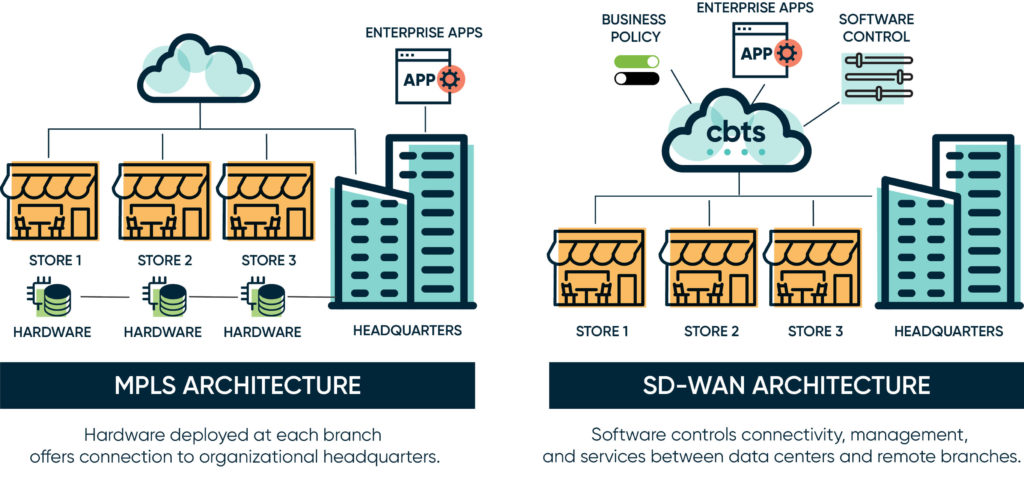
Read this article to understand what SD-WAN is, why it is vital for your evolving business needs, and tips on choosing the right SD-WAN partner.
Table of Contents
- What is SD-WAN, and why is it vital for your evolving business needs?
- What SD-WAN can do for your organization—and what it can’t
- SD-WAN ensures network safety and security, even in remote environments
- Industries that benefit from software-defined wide area networks
- How to build an SD-WAN architecture
- Choosing the right SD-WAN partner for your business needs
What is SD-WAN, and why is it vital for your evolving business needs?
A software-defined wide area network, or SD-WAN for short, uses software and cloud-based technologies to simplify the delivery of WAN services to branch offices. Software-based virtualization enables network abstraction that simplifies network operations, allowing busy IT managers to deploy Internet-based connectivity quickly and securely.
Although SD-WAN is a critical component of modern business agility, many organizations lack the infrastructure to stay competitive in today’s high-speed cloud networking environment.
Also read: SD-WAN for dummies
Companies relying on MPLS networks are stuck with high-latency/low-performance cloud applications, meaning remote users must settle for less from VoIP and other real-time applications. Moreover, security and management requirements often associated with MPLS tend to complicate branch operations and increase IT staffing costs.
It may be time for organizations considering a new beginning for secure branch networking to explore an SD-WAN solution.
Also read: Q&A: Secure networking utilizing robust SD-WAN solutions
What SD-WAN can do for your organization—and what it can’t
Traditional MPLS systems that transmit traffic from a branch to a centralized data center don’t deliver high-performance access to cloud applications, which is a mainstay of SD-WAN.
As the hybrid work environments settle in as the “new normal,” SD-WAN provides a range of benefits:
- Rapid deployment of bandwidth and firewalls removes the need for IT personnel to be on-site. The ability to easily add or reduce bandwidth means more agility for your business.
- Internet connectivity through SD-WAN—including cable, DSL, and ethernet—is quick to deploy and costs a fraction of equivalent MPLS circuits. Ultimately, software-defined wide area networks provide the advantages of reliable, secure WAN services at Internet-comparable price points.
- SD-WAN eliminates backhaul penalties of MPLS networks, leveraging the Internet to deliver secure, high-performance connections from branch to cloud. Remote users will also see improvements in their experience when using cloud/SaaS-based applications.
- SD-WAN can lay the foundation for organizations adopting SASE or a zero trust framework.
Also read: Technical guide to SD-WAN
As applications migrate to the Cloud, so will network functions. By moving these operations to the Cloud, businesses gain upgraded visibility and analytical insight while no longer having to manage their communications infrastructures at the local level.
From there, mission-critical applications can be layered into the cloud-delivered network. SD-WAN drives bottom-line outcomes by giving customers an improved experience when accessing these applications.
Also read: How SD-WAN is revolutionizing hybrid networks for the cloud era
SD-WAN may be a comprehensive solution for your networking needs. However, SD-WAN:
- Does not include the traditional, bookended WAN optimization applicable for private MPLS links and TCP-only connections.
- Is not just multilink WAN bonding with path control.
- Is not a last-mile cloud-gateway solution for providing application-based caching and acceleration techniques.
- Does not offer multilayer integration of packet and optical networks in a telco backbone.
- Is not private, dark-fiber networking that avoids telco services.
Watch: Why invest in SD-WAN?

By harnessing SD-WAN, companies can:
- Virtualize their networks.
- Enable a secure overlay.
- Simplify the delivery of services.
- Provide interoperability.
- Leverage cost-effective hardware.
- Support automation within a business policy framework.
- Monitor usage and performance.
- Support interoperable and open networking.
- Enable managed services.
Also read: Healthcare provider requires secure network
SD-WAN ensures network safety and security, even in remote environments
Many professionals working remotely struggle with insufficient wireless networks and constrained bandwidth—not the kind of “new normal” executives expect when maximizing branch capabilities and targeting mission-critical business goals.
Partnering with a proven service provider like CBTS empowers organizations to meet these new challenges. Use cases for a software-defined wide area network solution include on-premises, cloud, and hybrid deployment models that require a quality of experience (QoE) for VoIP and other real-time applications regardless of where users are located.
Watch: Enhance your end user voice and video experience with SD-WAN
Additional security strengths
SD-WAN delivers a secure cloud network through a secure overlay. This transport-independent overlay works across any combination of public-private circuits, enabling connectivity to both enterprise data centers and SaaS applications.
Additionally, an SD-WAN cloud security solution can be service-chained with another cloud solution to deliver protection from any number of external threats: phishers, scammers, bots, viruses, and more—even as users access the network remotely. This reduces strain on your organization’s data center and provides peace of mind for remote employees.
Also read: Protect your SD-WAN network with cloud-enabled security
Industries that benefit from software-defined wide area networks
A wide variety of verticals can see significant returns on their investments into SD-WAN, regardless of location or sector of the economy they occupy.
For example, retail and food service organizations often have narrow profit margins that limit the scope of networking infrastructure they can invest in. Software-defined wide area networks fit this niche thanks to lower infrastructure costs—without compromising connection quality.
Meanwhile, the healthcare industry also has unique needs for which SD-WAN is suited. With SD-WAN, healthcare agencies can create specific policies and customized routing protocols for their mission-critical healthcare applications and their large, widely distributed environments.
Government agencies also derive substantial value from the streamlined application and service management that SD-WAN offers, especially those with public-facing entities that must field thousands of phone calls per day. SD-WAN provides these organizations with a single pane of glass interface to manage their local, statewide, or even nationally distributed network environments.
Also read: Protect your SD-WAN network with cloud-enabled security
How to build an SD-WAN architecture
When the decision is made for your organization to begin transitioning to a cloud-delivered software-defined wide area networking environment, there are a few key factors to consider.

Firstly, your enterprise must determine whether to engage with a managed service partner to implement your software-defined wide area network architecture. There are many benefits to this, but care must be taken to choose an SD-WAN partner who will offer complete transparency into the transition process without demanding total control.
A successful SD-WAN deployment also depends on complete buy-in from your organization’s leadership. Executives must be thoroughly informed of the mission and goals of the SD-WAN transition to ensure an efficient and effective migration—having productive conversations early on and getting all sectors of the business invested in the smooth deployment of cloud-delivered SD-WAN.
Also read: Four considerations for building a remote network with SD-WAN
Choosing the right SD-WAN partner for your business needs
Identifying the right partner for your managed software-defined wide area network solution is crucial for organizations looking to build a network architecture supporting high-level business imperatives. Providers should have expertise in smoothly transforming a legacy MPLS network into a cloud-powered hybrid or SD-WAN architecture, regardless of industry.
A provider must also work with a client’s IT team to:
- Identify vulnerabilities.
- Map out the existing network environment.
- Plot out an optimal transition plan.
The right SD-WAN partner brings a modern approach to an enterprise’s security situation. Put simply, your would-be network provider should have layered and comprehensive answers to the question, “What is SD-WAN?”. Finding the perfect partner will help you assess your current network to optimize bandwidth and safeguard essential data and applications.
Also read: The key to finding the right SD-WAN provider for your organization
SD-WAN is defining both the present and future of enterprise networking. However, it takes an expert guide to navigate these turbulent waters. Choose your partner carefully to get the most out of this technology.
Follow the link for more information on how SD-WAN can modernize your network and threat management strategy.




















